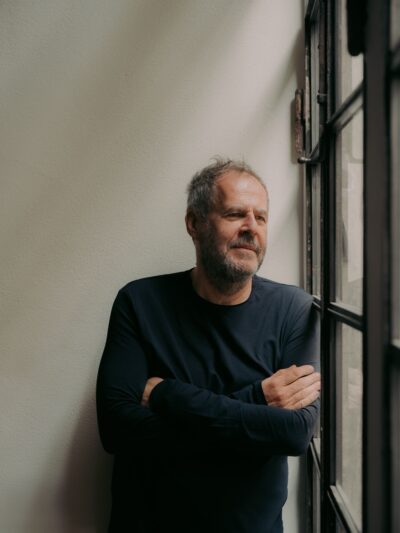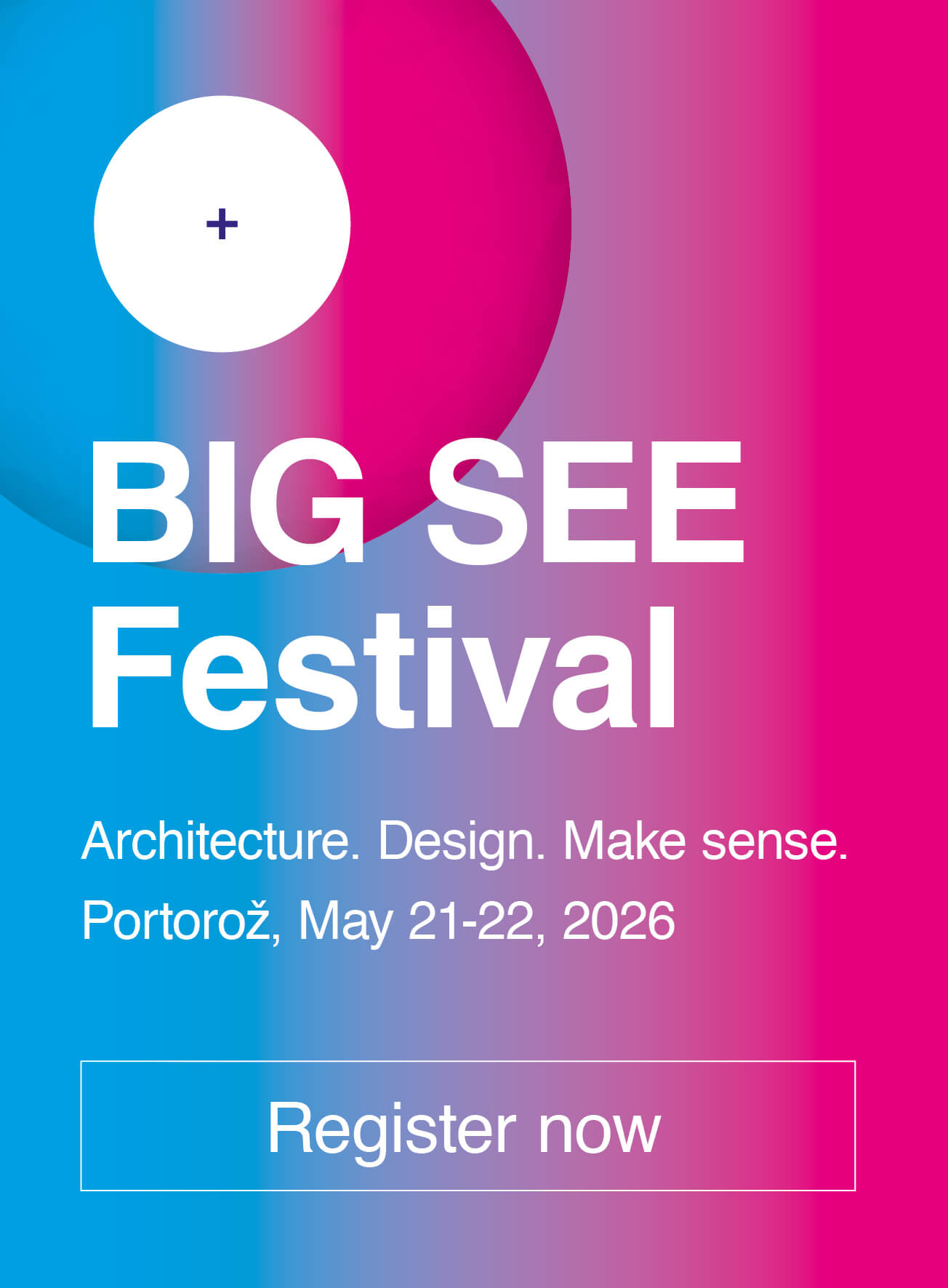
3 Questions for Mario Cucinella Architects
The Pavilion is a meeting point between two cultures, where the language of design becomes a shared space for memory, emotion, and future vision.
Q: How does the pavilion bridge Italian heritage with Japanese context and sensibility?
A: The Italian Pavilion bridges Italian heritage with the Japanese context and sensibility through a careful blend of architectural expression and experiential storytelling. The structure reinterprets core Italian values – such as hospitality, landscape, and Renaissance identity – through design elements that resonate with Japanese aesthetics, including modular wooden construction and light-permeable façades. The laminated wood framework, composed of beams and pillars, draws inspiration from Japanese technological systems while recalling the rhythm and elegance of a traditional Italian coffered ceiling. The immersive Theater merges Italian Renaissance traditions with Japanese performance culture, creating a hybrid space of dialogue and transformation. The Pavilion is a meeting point between two cultures, where the language of design becomes a shared space for memory, emotion, and future vision. The Italian Garden on the rooftop, intertwining native species from both countries, further symbolizes this meaningful cultural synthesis.

Q: What were the guiding principles behind the pavilion’s modular wooden structure?
A: The guiding principles behind the pavilion’s modular wooden structure were rooted in sustainability, reversibility, and thoughtful integration with the surrounding environment. Constructed using laminated wood from certified local supply chains, the structure employs dry construction techniques and modular logic to optimize material use, reduce waste, and streamline assembly. It follows advanced sustainability frameworks such as Design for Disassembly (DfD) and Design for Manufacturing and Assembly (DfMA), ensuring that each component can be traced, separated, and reused after the Expo. The Pavilion is not just built to stand, it is built to transform, to move, and to live on beyond its original context. This reflects a Life Cycle Thinking approach that emphasizes environmental responsibility while preserving architectural quality and adaptability.
The Pavilion is not just built to stand, it is built to transform, to move, and to live on beyond its original context.

Q: How do you design for emotion and cultural memory in a global exposition setting?
A: Designing for emotion and cultural memory in the Italian Pavilion involves creating immersive, multisensory experiences that activate reflection and participation. Each space functions as a narrative scene showcasing elements of Italian identity, from craftsmanship in the Ateliers of Italian Creativity to historical continuity in the Theater and the Ideal City. The integration of iconic works, such as Caravaggio’s The Deposition, fosters emotional and contemplative connections. The Pavilion highlights cultural memory through reinterpretations of traditional Italian forms and narratives, engaging visitors in a journey that blends the real and virtual, the familiar and the new. This approach transforms the Pavilion into a living, relational space where art, history, and innovation come alive in a globally resonant language.
The Pavilion highlights cultural memory through reinterpretations of traditional Italian forms and narratives, engaging visitors in a journey that blends the real and virtual, the familiar and the new.

About The Italian pavilion at Expo 2025 Osaka
Mario Cucinella, Architect and Founder of MCA, commented: “Designing the Italian Pavilion for Expo 2025 Osaka is a unique opportunity to create a true stage, not only to showcase the culture, history, and innovation of our country but also to establish a space for fostering connections: for future dialogue, for strengthening cultural, social, and economic ties. Aligned with one of the Expo’s themes, ‘Saving Lives’, the project and its architectural and technological content as well as the choices of material propose a renewed balance among humanity, nature and technology. The Italian Pavilion can become a powerful tool to promote, inspire action, and establish new synergies for the development of a more sustainable future. It represents a new vision of society and the city: a living organism where the relationships among people, art, the environment and history can come alive.”
The Italian Pavilion represents a living ecosystem that embodies the intersection of tradition and innovation, beauty and sustainability, shaping a new model of a sustainable and circular city. It is not just a building, but a true laboratory open to the public, designed to offer an immersive and multisensory experience, inviting visitors to discover Italian culture: a grand Hangar of Italian know-how, the pavilion will host artistic, scientific, entrepreneurial, and social experiments. The space will highlight and stimulate the creative DNA that belongs to Italy and is admired worldwide. Pieces of national heritage will be unveiled, deconstructed, and reinterpreted in unexpected and contemporary ways.
The architectural structure, open and welcoming, is designed as a space permeable to the light coming from the surrounding sky and sea. It features a large entrance marked by a transparent facade that filters natural light. The entire building is constructed with a modular wooden structure, creating dynamic interaction of light and shadow throughout the day.
Visitors embark on a creative journey that immerses them in the essence of Italy—its Renaissance colors, urban harmony, and cultural identity. The experience begins in the Ateliers of Italian Creativity, where digital craftsmanship, art, and research come together. It continues in the Theater, an intimate, interactive space that blends Italian and Japanese performance traditions through digital scenography and live shows. This multisensory setting blurs the line between viewer and performer, offering glimpses of imagined futures. At the heart of the Pavilion is the Ideal City, a space that reimagines Italy’s landscapes and their connection to humanity. It explores themes such as air quality, health, and urban design. Highlights include the Farnese Atlas, the Milan Cortina 2026 Olympic Torches, and a powerful encounter with Caravaggio’s The Deposition, displayed in a quiet, contemplative space that invites deep emotional reflection.
The Pavilion also hosts the space dedicated to Italian Territories, where different regions alternate over time and showcase their excellence and traditions through interactive and innovative installations. The experience culminates on the rooftop terrace with the Italian Garden, a contemporary reinterpretation of the Renaissance Garden tradition with a sustainable approach. This space serves as both a place of contemplation and a meeting point, where native Italian and Japanese vegetation intertwine. A sinuous, organic labyrinth offers visitors the opportunity to explore a new balance between humanity and nature, between the natural and the artificial, harmonizing the organic vitality of life with the rational design of humankind.
The entire Pavilion adheres to strict principles of sustainability and circularity, thanks to its modular wooden structure, the use of low-impact materials, and innovative technologies for energy and water management. With this project, the Italian Pavilion at Expo 2025 Osaka aims not only to represent Italy’s rich cultural heritage but also to serve as a living space that fosters exchange, relationships, and innovative ideas for a sustainable and inclusive future.






Mario Cucinella is an internationally renowned architect and a leading advocate for sustainable design. He graduated in Architecture from the University of Genoa in 1986 and founded Mario Cucinella Architects in 1992, now based in Bologna and Milan. In 2015, he established SOS – School of Sustainability, a postgraduate program focused on sustainable architecture. His work, blending environmental innovation with social responsibility, has earned him honors, including Fellowships from the Royal Institute of British Architects (2016) and the American Institute of Architects (2017).
Project
The Italian pavilion at Expo 2025 Osaka
Studio:
MCA – Mario Cucinella Architects
Lead Architect:
Mario Cucinella
Year of Completion:
2025
Location:
Osaka, Japan
Website:
www.mcarchitects.it
Instagram:
@mario_cucinella_architects
Portrait Photography:
Julius Hirtzberger
Project Photography:
Duccio Malagamba
Edited by:
Tanja Završki
Powered by

BIG SEE Talks with Mario Cucinella Architects
The Pavilion is a meeting point between two cultures, where the language of design becomes a shared space for memory, emotion, and future vision.
Q: How does the pavilion bridge Italian heritage with Japanese context and sensibility?
A: The Italian Pavilion bridges Italian heritage with the Japanese context and sensibility through a careful blend of architectural expression and experiential storytelling. The structure reinterprets core Italian values – such as hospitality, landscape, and Renaissance identity – through design elements that resonate with Japanese aesthetics, including modular wooden construction and light-permeable façades. The laminated wood framework, composed of beams and pillars, draws inspiration from Japanese technological systems while recalling the rhythm and elegance of a traditional Italian coffered ceiling. The immersive Theater merges Italian Renaissance traditions with Japanese performance culture, creating a hybrid space of dialogue and transformation. The Pavilion is a meeting point between two cultures, where the language of design becomes a shared space for memory, emotion, and future vision. The Italian Garden on the rooftop, intertwining native species from both countries, further symbolizes this meaningful cultural synthesis.

Q: What were the guiding principles behind the pavilion’s modular wooden structure?
A: The guiding principles behind the pavilion’s modular wooden structure were rooted in sustainability, reversibility, and thoughtful integration with the surrounding environment. Constructed using laminated wood from certified local supply chains, the structure employs dry construction techniques and modular logic to optimize material use, reduce waste, and streamline assembly. It follows advanced sustainability frameworks such as Design for Disassembly (DfD) and Design for Manufacturing and Assembly (DfMA), ensuring that each component can be traced, separated, and reused after the Expo. The Pavilion is not just built to stand, it is built to transform, to move, and to live on beyond its original context. This reflects a Life Cycle Thinking approach that emphasizes environmental responsibility while preserving architectural quality and adaptability.
The Pavilion is not just built to stand, it is built to transform, to move, and to live on beyond its original context.

Q: How do you design for emotion and cultural memory in a global exposition setting?
A: Designing for emotion and cultural memory in the Italian Pavilion involves creating immersive, multisensory experiences that activate reflection and participation. Each space functions as a narrative scene showcasing elements of Italian identity, from craftsmanship in the Ateliers of Italian Creativity to historical continuity in the Theater and the Ideal City. The integration of iconic works, such as Caravaggio’s The Deposition, fosters emotional and contemplative connections. The Pavilion highlights cultural memory through reinterpretations of traditional Italian forms and narratives, engaging visitors in a journey that blends the real and virtual, the familiar and the new. This approach transforms the Pavilion into a living, relational space where art, history, and innovation come alive in a globally resonant language.
The Pavilion highlights cultural memory through reinterpretations of traditional Italian forms and narratives, engaging visitors in a journey that blends the real and virtual, the familiar and the new.

About the Project
Mario Cucinella, Architect and Founder of MCA, commented: “Designing the Italian Pavilion for Expo 2025 Osaka is a unique opportunity to create a true stage, not only to showcase the culture, history, and innovation of our country but also to establish a space for fostering connections: for future dialogue, for strengthening cultural, social, and economic ties. Aligned with one of the Expo’s themes, ‘Saving Lives’, the project and its architectural and technological content as well as the choices of material propose a renewed balance among humanity, nature and technology. The Italian Pavilion can become a powerful tool to promote, inspire action, and establish new synergies for the development of a more sustainable future. It represents a new vision of society and the city: a living organism where the relationships among people, art, the environment and history can come alive.”
The Italian Pavilion represents a living ecosystem that embodies the intersection of tradition and innovation, beauty and sustainability, shaping a new model of a sustainable and circular city. It is not just a building, but a true laboratory open to the public, designed to offer an immersive and multisensory experience, inviting visitors to discover Italian culture: a grand Hangar of Italian know-how, the pavilion will host artistic, scientific, entrepreneurial, and social experiments. The space will highlight and stimulate the creative DNA that belongs to Italy and is admired worldwide. Pieces of national heritage will be unveiled, deconstructed, and reinterpreted in unexpected and contemporary ways.
The architectural structure, open and welcoming, is designed as a space permeable to the light coming from the surrounding sky and sea. It features a large entrance marked by a transparent facade that filters natural light. The entire building is constructed with a modular wooden structure, creating dynamic interaction of light and shadow throughout the day.
Visitors embark on a creative journey that immerses them in the essence of Italy—its Renaissance colors, urban harmony, and cultural identity. The experience begins in the Ateliers of Italian Creativity, where digital craftsmanship, art, and research come together. It continues in the Theater, an intimate, interactive space that blends Italian and Japanese performance traditions through digital scenography and live shows. This multisensory setting blurs the line between viewer and performer, offering glimpses of imagined futures. At the heart of the Pavilion is the Ideal City, a space that reimagines Italy’s landscapes and their connection to humanity. It explores themes such as air quality, health, and urban design. Highlights include the Farnese Atlas, the Milan Cortina 2026 Olympic Torches, and a powerful encounter with Caravaggio’s The Deposition, displayed in a quiet, contemplative space that invites deep emotional reflection.
The Pavilion also hosts the space dedicated to Italian Territories, where different regions alternate over time and showcase their excellence and traditions through interactive and innovative installations. The experience culminates on the rooftop terrace with the Italian Garden, a contemporary reinterpretation of the Renaissance Garden tradition with a sustainable approach. This space serves as both a place of contemplation and a meeting point, where native Italian and Japanese vegetation intertwine. A sinuous, organic labyrinth offers visitors the opportunity to explore a new balance between humanity and nature, between the natural and the artificial, harmonizing the organic vitality of life with the rational design of humankind.
The entire Pavilion adheres to strict principles of sustainability and circularity, thanks to its modular wooden structure, the use of low-impact materials, and innovative technologies for energy and water management. With this project, the Italian Pavilion at Expo 2025 Osaka aims not only to represent Italy’s rich cultural heritage but also to serve as a living space that fosters exchange, relationships, and innovative ideas for a sustainable and inclusive future.










